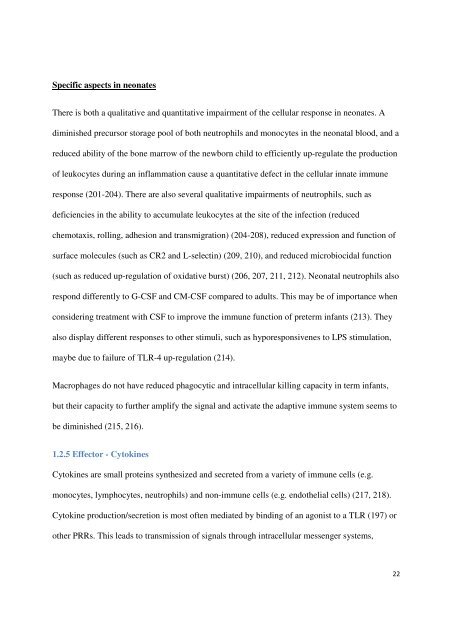Staphylococcus epidermidis - virulence factors and innate ... - Munin
Staphylococcus epidermidis - virulence factors and innate ... - Munin
Staphylococcus epidermidis - virulence factors and innate ... - Munin
Create successful ePaper yourself
Turn your PDF publications into a flip-book with our unique Google optimized e-Paper software.
Specific aspects in neonates<br />
There is both a qualitative <strong>and</strong> quantitative impairment of the cellular response in neonates. A<br />
diminished precursor storage pool of both neutrophils <strong>and</strong> monocytes in the neonatal blood, <strong>and</strong> a<br />
reduced ability of the bone marrow of the newborn child to efficiently up-regulate the production<br />
of leukocytes during an inflammation cause a quantitative defect in the cellular <strong>innate</strong> immune<br />
response (201-204). There are also several qualitative impairments of neutrophils, such as<br />
deficiencies in the ability to accumulate leukocytes at the site of the infection (reduced<br />
chemotaxis, rolling, adhesion <strong>and</strong> transmigration) (204-208), reduced expression <strong>and</strong> function of<br />
surface molecules (such as CR2 <strong>and</strong> L-selectin) (209, 210), <strong>and</strong> reduced microbiocidal function<br />
(such as reduced up-regulation of oxidative burst) (206, 207, 211, 212). Neonatal neutrophils also<br />
respond differently to G-CSF <strong>and</strong> CM-CSF compared to adults. This may be of importance when<br />
considering treatment with CSF to improve the immune function of preterm infants (213). They<br />
also display different responses to other stimuli, such as hyporesponsivenes to LPS stimulation,<br />
maybe due to failure of TLR-4 up-regulation (214).<br />
Macrophages do not have reduced phagocytic <strong>and</strong> intracellular killing capacity in term infants,<br />
but their capacity to further amplify the signal <strong>and</strong> activate the adaptive immune system seems to<br />
be diminished (215, 216).<br />
1.2.5 Effector - Cytokines<br />
Cytokines are small proteins synthesized <strong>and</strong> secreted from a variety of immune cells (e.g.<br />
monocytes, lymphocytes, neutrophils) <strong>and</strong> non-immune cells (e.g. endothelial cells) (217, 218).<br />
Cytokine production/secretion is most often mediated by binding of an agonist to a TLR (197) or<br />
other PRRs. This leads to transmission of signals through intracellular messenger systems,<br />
22
















